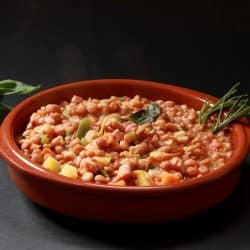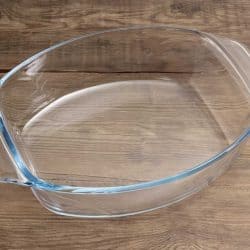Ready to clean up after enjoying that scrumptious casserole, but don't know whether your casserole dish is dishwasher safe? Not to worry! We've done the research on various types of casserole dishes to help you determine whether you should toss it into the dishwasher, or get it started soaking in the sink.
Whether a casserole dish is dishwasher safe really depends on the type of material from which the dish is made. If you are uncertain you can do one of two things; check if there is a dishwasher safe symbol on your dish or refer to the manufacturer's recommendations about how to safely clean your dish. Most modern casserole dishes are dishwasher safe.
Knowing what type of material your dish is made of or looking for dishwasher safe symbols can help cut out all the extra hassle and worry of getting it cleaned without causing damage. Please keep reading as we discuss which bakeware materials are dishwasher safe -and what happens if you mistakenly machine wash a hand-wash-only material. We'll also explain how you can remove stuck-on grime from your casserole dish with ease.
![Open front door of a dishwasher full of clean dishes and casserole on top, Are Casserole Dishes Dishwasher Safe? [Here's Which Ones Are]](https://kitchenseer.com/wp-content/uploads/2020/11/Are-Casserole-Dishes-Dishwasher-Safe-Heres-Which-Ones-Are.jpg)
How do you know if a casserole dish is dishwasher safe?
Casserole dishes are made from various materials, most commonly, enameled cast iron (Le Creuset), glass (Pyrex), ceramic, and stainless steel. These materials are typically dishwasher safe. However, be mindful that not all ceramic dishes are coated with a protective glaze for increased durability so you should check with the manufacturer particularly for older, ceramic casserole dishes.
Dishwasher Safe Symbols/Icons
There are two common dishwasher safe labels. One icon indicates that the dish is safe if placed on the top rack/draw of the dishwasher. Positioning is important because water streams and temperatures can be more intense in different areas of the dishwasher. Sometimes, bakeware requires gentle cleaning that can occur on the top rack/draw rather than harsher cleaning that can occur on the bottom rack/draw.

The other icon indicates that no particular placement is necessary for the dish to be safely cleaned in the dishwasher. If you see this symbol, go ahead and squeeze that casserole dish into any areas of the dishwasher where there is available space.

What Happens When You Put Non-Dishwasher Safe Dishes in the Dishwasher?
Discoloration or Etching
The strong jets in the dishwasher, and even some harsh detergents, can etch away the material of your casserole dish over time. You might notice a colored dish has become discolored or dulled. Glass dishes might appear cloudy. These are the results of etching. Hand-wash dishes to prevent altering their appearance. The dish material will remain oven-safe, not hindered by the long-term effects of the dishwasher.
Melted or Mishapen
High-intensity heat in the dishwasher is a big concern because extreme temperatures can melt or deform non-dishwasher safe materials. For this reason, some materials are recommended for top rack only placement in the dishwasher, where the water and steam temperatures are less intense. Older ceramic casserole dishes, for instance, might be prone to crack if exposed to fluctuating temperatures.
Otherwise, hand-washing your non-dishwasher safe dish using water that is hot enough for your hands to withstand will not cause damage. Avoid placing plastic casserole lids into the dishwasher, unless specified to be a dishwasher-safe material (many of these lids are not actually oven-proof either, rather used for food storage and transport after baking/cooling).
Corrosion
There is some general concern that putting metal dishes into the dishwasher will eventually cause corrosion. Stainless steel, however, is highly tolerant of corrosion, and unless the metal has been cracked or damaged it is unlikely for stainless bakeware to corrode. So, putting a stainless casserole dish into the dishwasher is totally acceptable. It is recommended to locate stainless steel on the top rack, if possible.
How do you get burnt food off a casserole dish?
The best way to remove burnt food from casserole dishes would be to first soak the dish in a solution of warm water and dish detergent and then, use baking soda for resistant, burnt-on food. Remove any large pieces of burnt food by scraping out the dish with a spatula. Get ready to clean!
First, let the dish soak in clean, soapy water. Some people even leave their dishes overnight to soak so that all the buildup will be much easier to clean off. Soaking softens the stuck-on food residue and lifts it gently from the surface of the dish, so you'll need to scrub less. After the soak, you can use the spatial again to remove any large chunks of food that come away readily.
Prepare a paste using baking soda and water. Using a soft dishcloth or sponge, apply the paste to the areas where remnants of burnt-on food remain. Scrub the dish, and continue until clean. The baking soda is mildly abrasive to loosen the food from the surface of the dish without causing damage to the material. Finally, wash out the dish with detergent and rinse with clean water. Set aside or towel dry.
We've found all the best cleaning solutions around your house for stuck-on food. Please read, "How to Clean a Burnt Casserole Dish [8 Effective Ways]."
Final Thoughts

Take a look at your casserole dish to locate the dishwasher safe symbol -either a top rack only or dishwasher safe icon. Once the telling symbol is located, you can be sure that your casserole dish material is dishwasher safe. So, load it into the appropriate position and run the dishwasher's cycle for your dish to come out sparkling clean. In order to efficiently clean your non-dishwasher safe casserole dish, without damaging it, follow the recommendations that we've previously discussed.
Need to use another type of dish in a pinch, while your casserole dish is soaking? Check out, "What Can I Use Instead of a Casserole Dish? [5 Alternatives]."



![Vegetable, rice and zucchini casserole, How To Clean A Burnt Casserole Dish [8 Effective Ways]](https://kitchenseer.com/wp-content/uploads/2020/11/vegetable-rice-and-zucchini-casserole-How-To-Clean-A-Burnt-Casserole-Dish-8-Effective-Ways-250x250.jpg)


